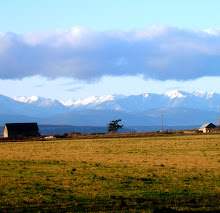 (Photo by Sierra Young)
(Photo by Sierra Young)Any plant that has spikelets ranks high on my long and growing list of cool things about Ebey's Reserve. Hordeum vulgare, or barley, is a grass grown as a cereal grain, livestock feed, and hops for brewing beer. At this time of year the spikelets give verdant fields all over the Reserve a soft look, especially when the wind creates wave patterns across acres of barley, inviting onlookers to relax and set their thoughts free onto the prairie.
 Local farmer harvests barley on Ebey's Prairie in front of the Ferry House (Photo by Mitch Richards)
Local farmer harvests barley on Ebey's Prairie in front of the Ferry House (Photo by Mitch Richards)Barley is an annual grass, meaning it must get its seeds into the soil in order survive, unlike perennial plants, like the sunchoke, whose roots survive underground and store energy over the winter to sprout new growth the following year. Wild barley grows spikes that contain the seeds, and when these spikelets reach maturity they split open so that wind and animals can disperse the seeds. Domesticated barley, however, has a mutation so that its spikelets are non-shattering, making it easier to harvest the ears. Farmers then plant new seeds for the next year's crop.
Ancient Egyptians used barley to make beer and bread. It has also been a staple in Tibet since the fifth century A.D., where it is made into a flour product called tsampa. Today it is cultivated in temperate climates as a summer crop and in tropical climates as a winter crop. Barley thrives in cool conditions, but it not very winter-hardy, making the mild climate of Central Whidbey Island an ideal place to grow it. It is also relatively tolerant of soil salinity, making a practical seaside crop, as it is here.
 (Photo by Sierra Young)
(Photo by Sierra Young)As you walk, bike, or drive through Ebey's Reserve, by all means enjoy the more distant vistas of the rugged Olympic Mountains, Mt. Baker and Mt. Rainier, but don't forget the simple beauty of barley fields on the prairie--the same fields that the pioneers began farming here more than 150 years ago.
Post by Sierra Young






